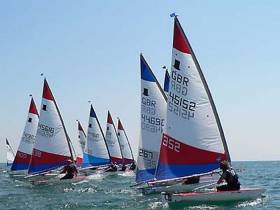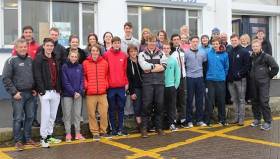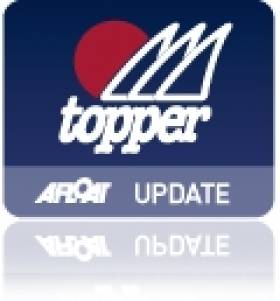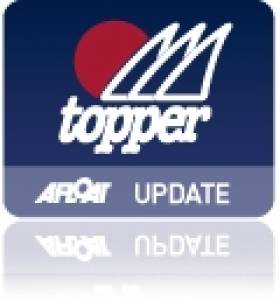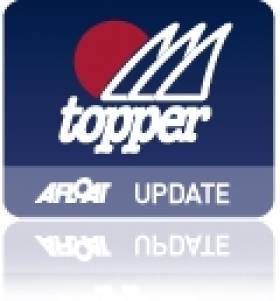Displaying items by tag: Topper
Topper Worlds 2016 At Ballyholme Yacht Club This Month
The 2016 Topper Worlds at Ballyholme from July 23rd will see a strong international fleet with a large contingent from China, but for the first time ever, the most numerous national contingent will be from Ireland. The World Championships will be held on the waters of Belfast Lough from the 23rd to the 29th of July 2016, hosted by Ballyholme Yacht Club in Bangor, County Down. It’s the first time that the Topper Worlds have been held in Northern Ireland in sixteen years – they were staged at Cushendall in County Antrim in 2000.
Bill Brassington, President of the International Topper Class Association, has stated: “The International Topper Class is extremely excited to be returning to Ireland for our 23rd World Championship in 2016. Ballyholme Yacht Club and the waters of Belfast Lough are set to provide exciting and competitive racing afloat and a friendly community ashore, which competitors and their supporters will greatly appreciate.”
The event comprises two World Championship series, and as the International Topper is a World Sailing recognised centreboard dinghy, the winners of these Championships are officially acknowledged as World Champions. The first World Championship will be made up competitors using the standard 5.3m2 sail, and has over 150 entrants.
The second World Championship is comprised of approximately 50 boats using the smaller 4.2m2 sails. The Intercontinental Cup will be presented to the top female sailor in the 5.3m2 fleet and an International Masters event will be held which is open to all male and female sailors over the age of 21.
There is a strong international element to the Rooster International Topper World Championships, with competitors from ten countries across four continents. China will send a team of 32 sailors to the Worlds, the largest entry from outside Europe, and the third largest country group overall in the Championships.
The second largest entry is from Great Britain, while for the first time ever, the largest entry is from Ireland with a total of 84 Irish sailors to date. Other countries that will be represented at the competition are Turkey, Macau, Japan, South Africa, Australia, Thailand and France.
It’s expected that by the time racing is under way, the event will have attracted over 200 sailors who, together with their coaches, family members and supporters, will bring over 700 visitors to Northern Ireland. These visitors may be interested in touring some of the local attractions such and taking in the natural beauty that Northern Ireland provides, as the area has much to offer within easy travelling time.
The light and durable design of the award winning International Topper makes it perfect for youth competitors. In fact, the Topper is an Olympic Youth Pathway class in both Great Britain and Ireland. The average age of competitors is therefore quite young but there will be sailors of all ages competing at this year’s Worlds, with the youngest competitor being 7 years old while the oldest is 61.
Over 48,000 Toppers have been built and sold worldwide and the boat is sailed in over 50 countries. The International Topper Class is delighted that many former Topper sailors have moved on to Olympic participation. In Great Britain, five former Topper sailors are competing in the Rio 2016 Olympics: Giles Scott, Alison Young, Nicola Groves, Dylan Fletcher and Alain Sign.
Representing Ireland at the Rio 2016 Olympics will be Ballyholme's former Topper sailors Ryan Seaton and Matt McGovern, along with Annalise Murphy and Finn Lynch, who won Silver in the Topper World Championships in 2011. Helena Lucas MBE will also be competing for Great Britain in the Paralympics.
The Irish National Sailing & Powerboat School has been active this winter in anticipation of a busy summer season writes Principal Kenneth Rumball. Through various acquisitions the following additions to the INSS fleet have been made, 13 sit–on Kayaks, five double Kayaks, three rescue boats, 14 Laser Pico Training dinghies, 12 Topper dinghies, two topaz dinghies, three Topper Vibe dinghies, 10 Optimist dinghies and the purchase of another 6.5m fast RIB for our busy powerboat courses.
We have recognised a growing demand at the Irish National Sailing & Powerboat School and we are being proactive in our purchase of equipment ahead of what we hope will be a busier than ever season! Our latest additions show our commitment to continue to be the leading Sailing & Powerboat Training centre in Ireland catering for everybody from the novice power-boater or sailor in dinghies and yachts to a seasoned racer looking to upskill or the experienced power-boater looking to take his skill to the next level. With the current fleet size of sailing and powerboats in the INS&PS standing at over 200 boats, we certainly have the capacity to get everybody on the water.
Our new fleet of course requires more instructors and for this we have been busy training staff not only to fulfil the demands of the Irish National Sailing & Powerboat School but also of the country of Ireland. The Easter break was particularly busy with an ISA Dinghy Instructor Course run before the Easter weekend with 8 attendees and then after the Easter weekend we ran an RYA Dinghy Instructor Course with 18 attendees. We also ran possibly the first RYA Cruising Instructor Course to be held in Ireland over the break, training instructors to the level required to teach up to Day Skipper Practical level on the new ISA and RYA Cruising schemes. Not forgetting the other ISA Dinghy Instructor Courses, RYA Powerboat Instructor Courses that have already been run this year.
Here is a quote from one of our newest dinghy instructors;
“I'm just after completing my dinghy instructor course in the INSS and am so excited now to be able to pass on my skills to younger sailors and adults alike! The course was tiring at times but we all learnt so much and really enjoyed ourselves. It really was a fantastic week and year of training.” - Clodagh Quinn
Now that we have the extra boats and staff in place, we are gearing up for what we hope will be a busy and enjoyable summer.
Volvo Car UK Announces Sponsorship of Topper Class
Volvo Car UK is delighted to announce sponsorship of a third youth class in 2016 – the International Topper Class Association (GBR.
Volvo Car UK has been a key sponsor of British sailing since 1999, supporting everything from youth development at grass roots through to Britain's top sailors at the pinnacle of the sport.
Recognised by the Royal Yachting Association as a Pathway Class, the Topper enables young dinghy sailors to develop their racing talent towards sailing in the Olympic Classes. Some of Britain's great athletes have progressed from the class, including three-times Finn World Champion, Giles Scott. Giles hopes to bring a medal home for Britain in this summers' games.
The Topper Class comment on their excitement over the new partnership, "Volvo's commitment to sailing and youth sailing is legendary. We are delighted to welcome Volvo onboard as a title sponsor in order to help us deliver our ambition of developing the best young racing sailors.
"Together with Volvo, our mission is simple - to advance the education, physical and mental development of young sailors, and for them to achieve their full potential, whilst having fun, becoming independent and learning to co-operate with others."
Designed in 1977 by Ian Proctor, the International Topper's colourful 'fun factor', combined with its serious racing pedigree, grabbed the attention of the sail training world and helped revolutionise the way sailing is taught. Having two sail sizes for the Topper allows sailors from 9 to 16 years old to compete nationally.
There are now nearly 50,000 Toppers worldwide. In the UK, the class holds around 70 events annually, attracting about 1,400 participants.The weekend of 27th February will see more than 175 Topper sailors take to the 2012 Olympic waters of Weymouth as they compete at the first National Series Event of 2016, hosted at Weymouth and Portland National Sailing Academy.
#topper – Inspite of a strong UK sailing team presence to swell the national championship fleet, Waterford Harbour's Geoff Power outwitted a fleet of 64 to win the Irish Topper dinghy title at County Antrim Yacht Club. The Dunmore East sailor finished with a score of 1 2 1 1 4 1 2 9 to beat Starcross's Eleanor Poole.
Third was another UK sailor Samuel Cooper from West Lancashire Yacht Club. Full results are downloadable below.
The national title win follows Power's win of the Ballyholme Topper Traveller series in May.
The last day of racing made even more special at the Whitehead venue with an appearance by the Red Arrows display team that flew overhead to celebrate the Tall Ships at nearby Belfast.
A large Royal Cork team made the long trip north and returned home with some encouraging results including Tom Keal fourth overall, Cian Jones sixth overall & first under 17. Caoimhe Foster seventh over all and first Irish Lady.
McIlwaine Heads Topper Fleet At Malahide Yacht Club
#toppers – Malahide Yacht Club hosted its first ever Topper regatta – the Traveller No.1 event - on Sunday 28th June with three back-to-back races for 40 competitors in fresh, blustery westerly winds on the Broadmeadow Water.
For the majority of the competitors, it was their first time to compete at the North County Dublin venue and they enjoyed the flat water and non-tidal conditions over courses set by Race Officer Brian McDowell.
In the 31-boat full rig fleet, honours went to Luke McIlwaine (NYC/CLYC) who posted three firsts to finish 5 points ahead of nearest rival Ellen McCarlie (County Antrim YC) who won the 1st Girl trophy as well. Third place went to Shane O'Brien of Howth YC.
In the 4.2 fleet, with nine entries, Dan McGaughey (Donaghadee SC) with two firsts and a second topped the leaderboard just one point ahead of Erin McIlwaine (NYC/CLYC).
"We were delighted to host the event for the Topper Class," said MYC Commodore Graham Smith, "and pleased that our facilities, race management and general organisation met with approval of the competitors and their parents."
Topper Traveller at Ballyholme Yacht Club
#topper – The two main prizes in last weekend's Topper Traveller went to Geoff Power from Waterford and Erin McIlwaine from Newcastle. However there were good performances by local sailors with Charlie O'Neill taking 8th in the full rig fleet as well as best Under 12. In the 4.2 fleet Dan McGaughey and Mathew Bell (Donaghadee) were 4th and 6th, and from Ballyholme in the 4.2 fleet, Oliver Haig was 5th, Katie Shivers came 7th and Adam Lockhart and Hanna Dadley-Young were 8th and 9th.
Saturday 16th May 2015 saw the start of the two day Irish Topper Traveller at Ballyholme Yacht Club (BYC) in Bangor with competitors travelling from all over Ireland to compete.
As with the Traveller the first day, Saturday, was spent with training under the control of the ITCA (IRL), where our young sailors were grouped and afforded an experienced instructor for professional development.
When registration had opened for the training and racing some days earlier, the indication was clear that there was a significant interest from the class in Ireland to make the journey to Ballyholme, to the point that the ITCA with the help of BYC had to source additional instructors to meet the demand.
As the weekend approached the long range weather forecast, with what appears to be the norm of late, was for high winds, and concerns were voiced as to whether the Topper Traveller would indeed be stranded on the shore.
The interest previously expressed came to fruition with a good number of sailors arriving for their training. The fleet took to the water around mid morning and the more experienced sailors from the Topper squad headed out of Ballyholme Bay with the less experienced staying closer to shore. However as the predicted high winds and squalls arrived a decision was made for the less experienced sailors to return to shore followed by the more experienced. The lack of on-water activity did not in any way dampen the enthusiasm and spirits of the young sailors as was soon to be demonstrated on Sunday.
With the arrival of Race day Sunday, BYC was a hive of activity as everyone prepared for some challenging racing conditions. At about 1030 hrs Mr Robin Gray our Race Officer with his team headed out to the race arena in Belfast Lough where the committee boat anchored, and wind readings recorded. With a strong wind out of the west readings over the next 90 minutes indicated a base line of around 22 knots with gusts of 27 knots, this coupled with a rising sea state resulted in a decision to move the course further inshore and the committee boat set up station between Ballymacormick Point and Lukes Point. The mark teams were soon put to work as the fleet was released from the North and South slips at BYC and light work was made of getting to the race arena. Some 48 entrants had registered in the full rig and 14 entrants in the 4.2 category.
With the race arena in a less exposed area, racing was soon under way. The race team recorded baseline wind conditions in the early 20s as the full rig fleet started followed five minutes later by the 4.2 fleet. The first leg kept the Rescue Team gainfully employed as the fleet got to grips with conditions at the mouth of the bay. However as they progressed into the bay the fleet travelled swiftly round the course.
Upon crossing the finish line of Race 1, one young sailor from Royal Cork Yacht Club was heard to express his delight at the conditions of sailing to a friend.
Race 2 saw similar conditions however with a reduced fleet and again with the knowledge gleaned from the earlier race the committee boat had the pleasure of observing some fine racing in both fleet categories.
Race 3 saw a significant reduction in wind speed and sea state with the race team recording wind speeds in the mid teens. However we did see the odd gust push through keeping the sailors mind focused.
Mr Geoff Power demonstrated some magnificent sailing and was rewarded with a win in all three races in the Topper full rig.
Mid afternoon saw the end of racing and all returned safe and well to BYC.
Results
Full Rig 1st Geoff Power Waterford Harbour Yacht Club
2nd Caoimhe Foster Royal Cork YC
3rd Juliette Kennedy Strangford Lough YC /more
4.2 Fleet 1st Erin McIlwaine - Newcastle Yacht Club / Carlingford Lough Yacht Club
2nd David Jones - Royal Cork Yacht Club
3rd Ellen Barbour - County Antrim Yacht Club
First Lady - Caoimhe Foster - Royal Cork YC
Under 17 1st Amy Carroll - Kinsale Yacht Club
2nd Cian Jones - Royal Cork Yacht Club
3rd Ellen McCarlie - County Antrim Yacht Club
Under 14 1st Paddy Cunnane - Dingle Sailing Club
2nd Juliet Nyhan - Royal Cork Yacht Club
3rd Fouad Ghareeb - Lough Earn Yacht Club
Under 12 1st Charles O'Neill - Ballyholme Yacht Club
2nd Rory Williamson - East Antrim Boat Club / County Antrim Yacht Club
Aidan Pounder, Rear Commodore Sailing thanked all those volunteers who made this event the success that it was To name a few - Mr Simon McIlwaine and his team from the ICTA (IRL), Robin Gray and his race team, Mr Martin Watson for Committee Boat, Mr Paul Wyness for results, Mrs Jo Rennie and Mrs Claire Shivers for the Club House volunteers and meals, Mr Phil Martin and Mr Andrew Dadley for help in organising and Mr Chris Penney and the coaching team, Mr Richard Honeyford, RYANI and all the competitors and volunteers. A particular thanks goes to Jumpin Java (Mr & Mrs Frank Shivers) for their kind sponsorship for the meals.
#topper – This weekend sees the third installment of this years Irish Topper Traveller circuit, hosted by Ballyholme Yacht Club.
On Saturday there are 40 Toppers registered for the training day with 10 travelling from Cork and a strong, if still young, contingent from the host club - in both full rig and the growing 4.2 fleet. This is now probably full although if you are still interested, please contact Simon McIlwaine to see if there are any cancellations or availability.
On Sunday there will be three races on the course for next years Topper World Championships giving sailors the chance to acclimatise to the local conditions. Many NI boats will have regularly visited the club at the RYANI Youth Championships which Ballyholme YC have hosted over the last 3 years with over 70 Toppers attending last year. Ballyholme YC however hasn't hosted a Topper Nationals or Provincial event since 2011 so it may be a first time for many from the ROI to visit one of Ireland's busiest dinghy clubs. Ballyholme YC is of course home to Ireland's only Topper World Champion (2013) Liam Glynn who is now competing in Laser Radials and recently won a Laser Radial Eurocup event in France.
Competition Intensifies at Youth Nationals and Optimist Trials
#youthnationals – The Irish Sailing Association (ISA) Pathway Youth Nationals 2015, taking place at Royal Cork Yacht Club are in their second day of competition at Crosshaven writes Claire Bateman. Topper, 420, Laser 4.7 and Laser Radial classes are competing in selection trials for National squads and potential selection for the National Academy. The four-day event also sees the International Optimist Dinghy Association Ireland, 2015 Optimist Trials take place with over 60 entrants.
Today began as a foggy grey day with the breeze more from the south and with a fitful sun trying to break through the clouds like a patchwork quilt on the water later in the day. The wind also increased at this stage going to 16 to 18 knots with a slight hint of west in it. A third Race Committee was called to action under the highly experienced Race Officer David O'Brien of Royal Cork for the 4.7s and the Toppers who were commencing racing today. To a person doing a tour of the three race areas, looking at racing with inner loops and outer loops, separate finish boats, on the water Juries blowing whistles signaling to the unwary, or possibly not unwary, that they had infringed the rules, it all appeared a very competent and slick operation timed to the last. The race team for the 420 and Radials moved further east on the Eastern Bank opposite the Aghada Sailing and Tennis Club where they had to wait a little bit longer for the wind to reach them. When it did it was great to see these fleets surfing on the waves.
In the 420 Class Peter McCann and crew Harry Whitaker from RCYC are the current leaders, followed by Douglas Elmes and Colin O'Sullivan, RCYC/ HYC, while the younger McCann brother James and crew Bill Staunton, RCYC, are in fourth place with Lizziy McDowell and Anna O'Regan from MYC taking the third spot..
In the Laser Radial fleet after six races and one discard Conor Beirne RStYG leads Erica Ruigrok from Rush SC in second followed by Cian Byrne from the host Club in third place.
Meanwhile the 29 boat Topper fleet, having sailed three races, are now led by Geoff Power WHSC, followed by Luke McElwaine from Carlingford Lough, tied on points but with count back putting McElwaine in second place and Caoimhe Foster RCYC taking the third spot.
In the 30 boat Laser Radial Fleet Richard McGinley of the Host Club leads from Ross Morgan SSC, second followed by Rebecca O'Shaughnessy, RCYC 3rd.
In the Optimist 60 boat fleet with Ireland's top sailor Anthony O'Leary as Race Officer the fleet sailed on a traditional Optimist course and had a long day sailing four races bringing their total to seven to date on this weekend which is an Optimist Trials Event confined to sailors who qualified at regional events and the Nationals in 2014. Current leader is Tom Higgins, RStGYC, followed by Gemma McDowell, MYC and Harry Bell, HYC third.
Racing continues tomorrow (Saturday) and tensions are now mounting at this stage of the weekend. Forecast is for fresher conditions and some exciting sailing should be seen throughout the fleets.
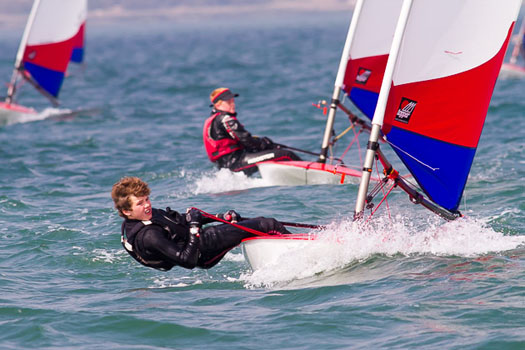
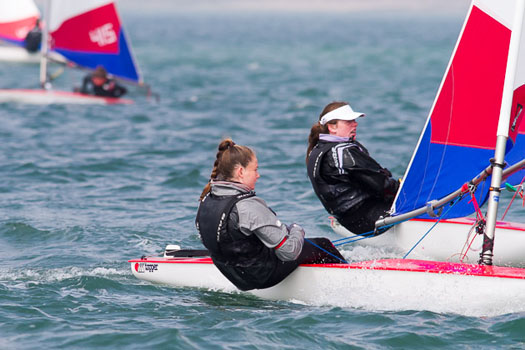
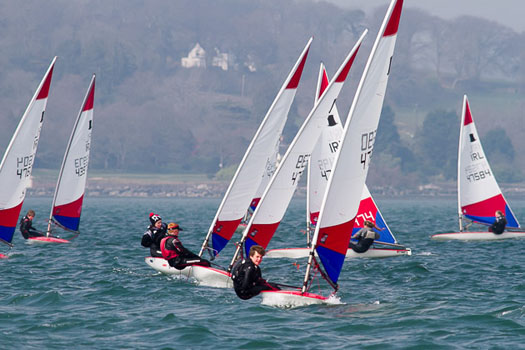
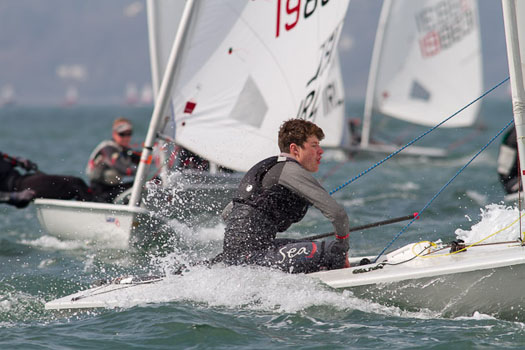
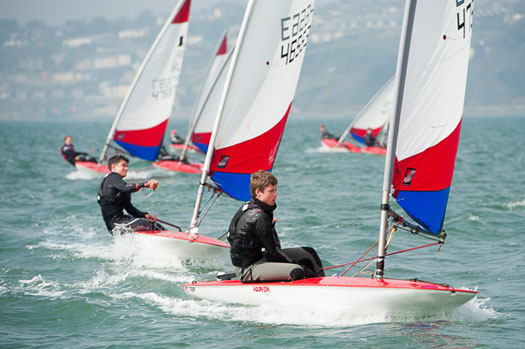
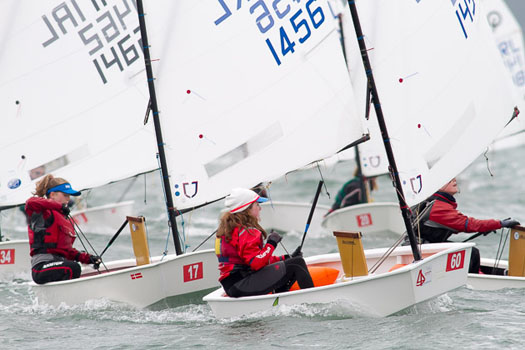
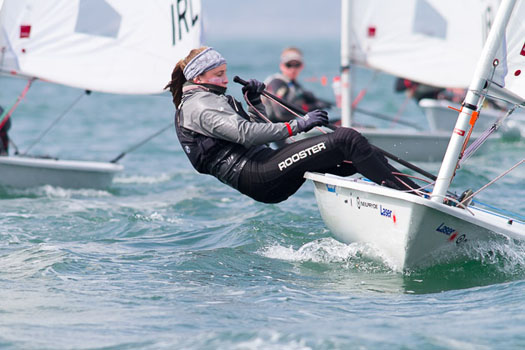
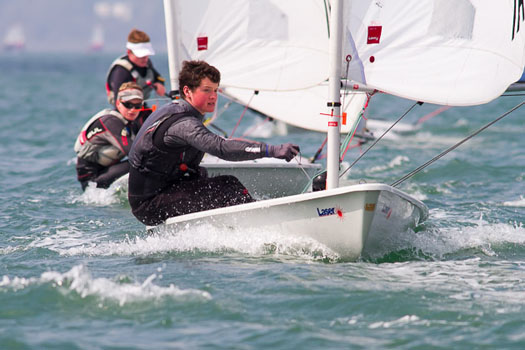
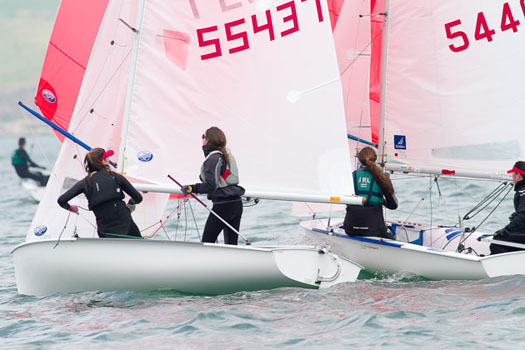
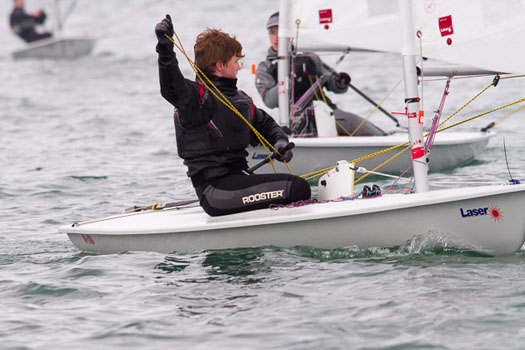
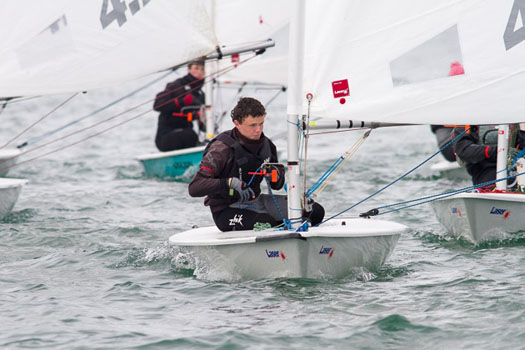
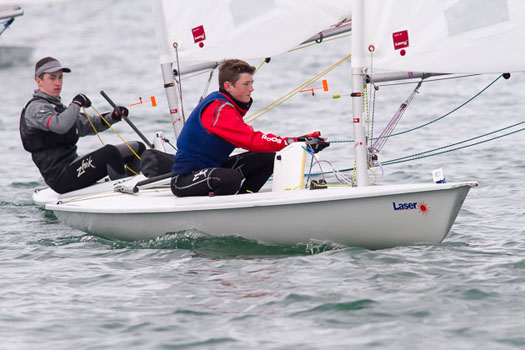



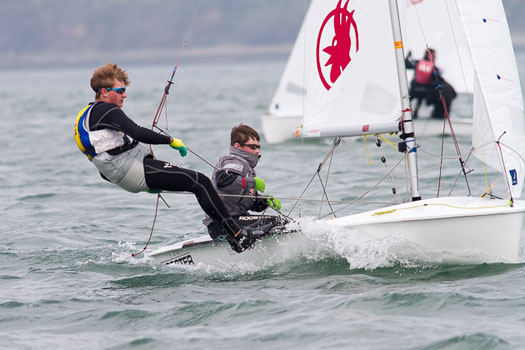
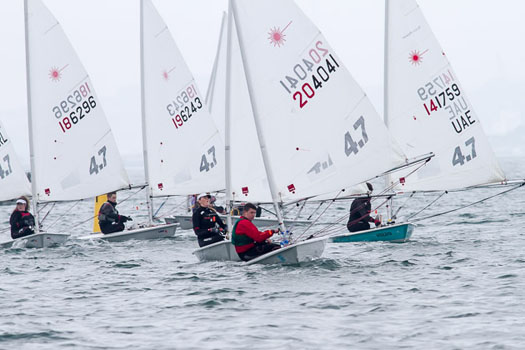

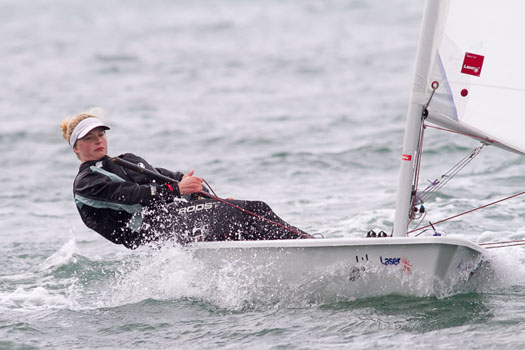
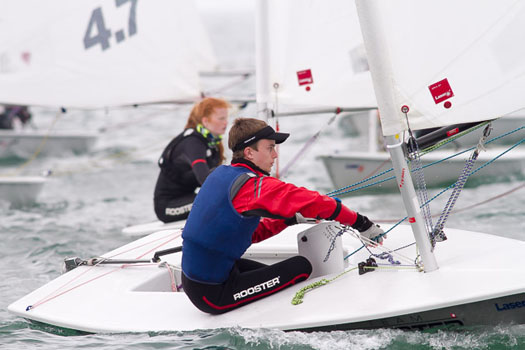
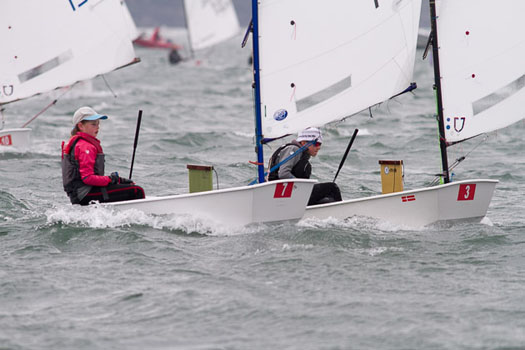
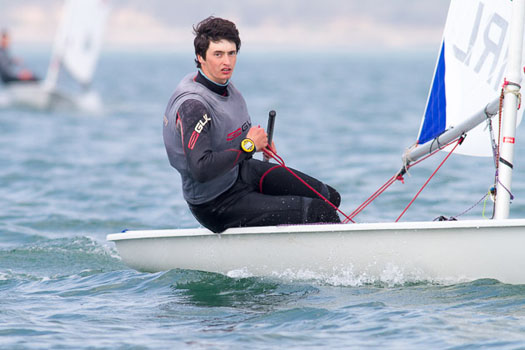
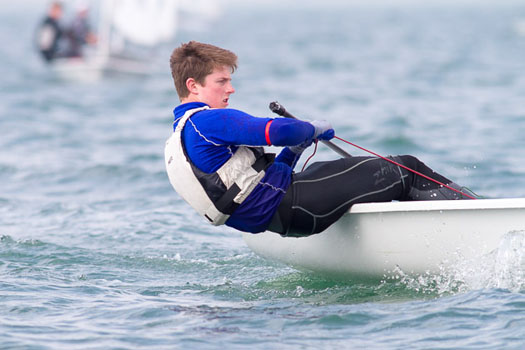


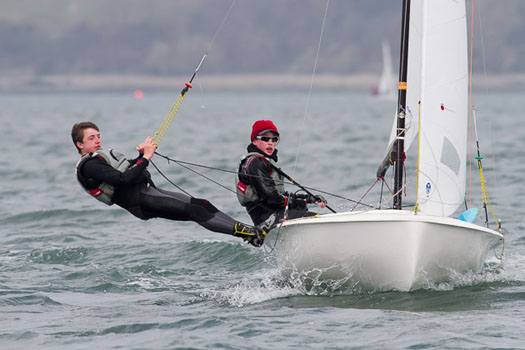
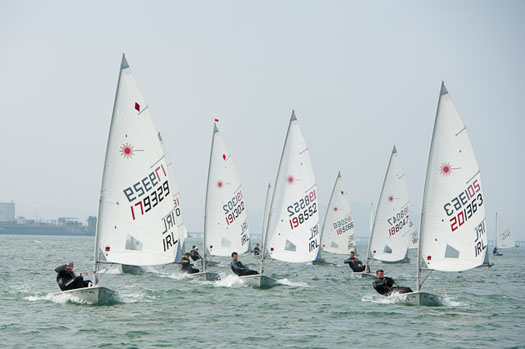

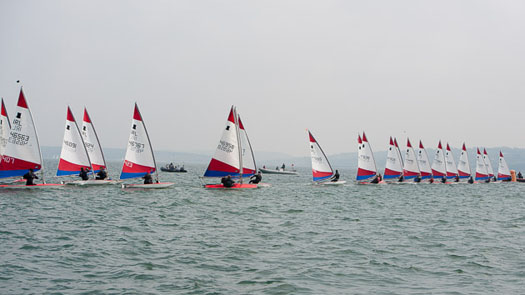
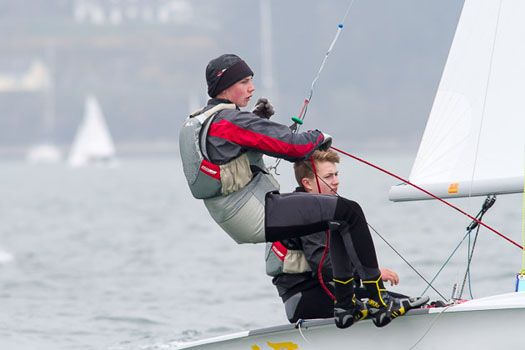

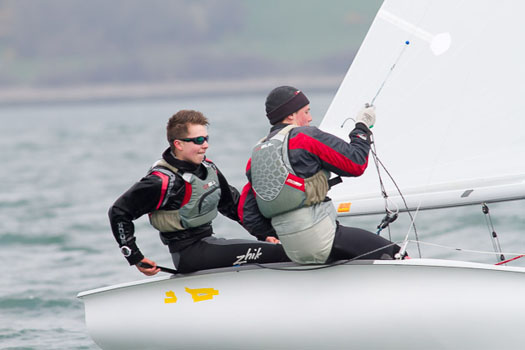
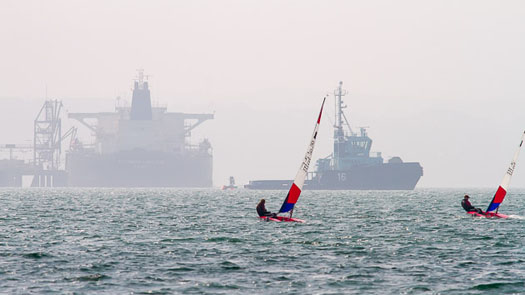
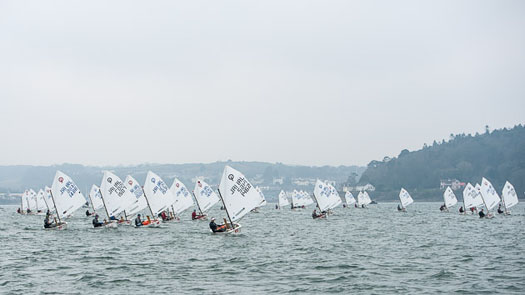
Toppers Make a Move At Royal Cork Yacht Club
#topper – Throughout the summer season at the Royal Cork Yacht Club some new brightly coloured red, blue and white sails have been making their presence felt on the waters of Cork Harbour writes Claire Bateman.These are the sails of the Topper Class that is attracting new support very quickly.
Moving up from the Optimist Class has long been a bone of contention for both sailors and their parents as to what would be a suitable step up or follow on boat. This was also a topic with the Irish Sailing Association even going back to the days when it was the Irish Yachting Association.
Young sailors and their parents now have an extra choice with the addition of the Topper Class, that appears to be winning favour very quickly, and has grown to 13 boats in a very short period of time under the guidance of Class Captain Imelda D'Arcy. Sailors in the Topper fleet have enjoyed considerable success throughout the season and we now have sailors in the Club enjoying follow on boats consisting of 420s, Laser 4.7s, Fevas and Toppers.
At the recent Junior Laying Up Supper a new specially commissioned trophy was presented to the winner of the October League. This trophy was designed by Artist Paddy McCormack, at the behest of Mary and Brian Jones, and is to honour the memory of the late Bill Jones, The winner of the first time presentation of this prestigious perpetual trophy was Tom Keal who has very recently moved from the Optimist Class to the Topper Class.
#topper – Royal Cork sailor Adam D'Arcy has won Silver at the Topper World Championships in Pwllheli, Wales. The Fermoy sailor beat 132 competitors from France, Great Britain, India, Japan, Malta, and South Africa. It's a second youth silver for Royal Cork in as many months. In July, ISAF youth silver went to D'Arcy's club–mate Seafra Guilfoyle in the Laser radial class.
As Afloat reported earlier, a total of 11 races were sailed during the regatta in a mixture of weather conditions that concluded this afternoon.
The 16–year–old had a total of 27 points to be on equal points with winner Calum Rosie from the UK, however agonisingly Ireland missed out on Gold on the count-back rule. Last year Ulster sailor Liam Glynn won the world title when the regatta was held in France.
The Gwynedd championship culminated today with four races with podium positions alternating after each race. It made for a nail biting climax to see who would be crowned World Champion. In the end it was Calum Rosie who took the final race win and with it the World Title.
Waterford's Geoff Power finished 10th overall while Peter Gilmore, Heather Spain, Conor Quinn and Hugh Perrette all finished within the top 30.
Top 5 Topper World Championship Results
1. Calum Rosie, UK – 27 pts
2. Adam D'Arcy, Ireland – 27 pts
3. Tom Walker, UK – 28 pts
4. Bella Fellows, UK – 32 pts
5. Oliver Blackburn, UK – 37 pts
Full results here


























